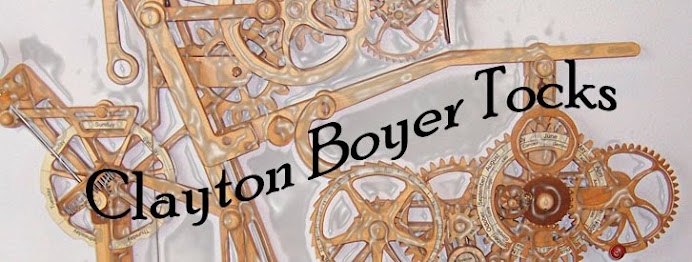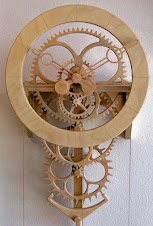8/23/15
8/17/15
A Question About Wind Cord
Can you please tell me what string you've found to be successful for clocks? Thanks, Doug
Aloha Doug,
I have not had a binding issue on any of the normal weight clocks using the "Surf Caster Braided Nylon Squidding Line". The only time I have noticed wind cord binding is if I have left too much excess wind cord on the wind pulley, or on the heavier weighted, extended run clocks like the Leeds. But even in these heavily weighted clocks wind cord binding is not common.
When I rewind the Leeds, I pull down on the CW cord and because the drive weight is nearly 18 pounds, I simultaneously gently lift the Weight - however, not taking all the weight off the weight cord.
John Hilgenberg noticed that when one of his clocks was rewound, the cord would bind upon itself. He also discovered the cause ~ the feeder pulley was off-set a little so that the cord fed heavily onto one side of the wind pulley. He got the binding as the cord collapsed upon itself inside the wind pulley. So you will want to be sure your guide pulley (if you have one) is aligned into the approximate center of your wind pulley.
With something like the Simplicity Variant or Number Six, with their low drive weight, I just wind the mechanism with the key and don't even touch the weight.
If you have the extended run time, dual weight option on your Number Six, you may want to assist by gently lifting one weight up during winding.
On my Hawaiian Time, with the dual weight cords feeding into the same pulley, I do gently assist one of the weights as I rewind with the key...but I think this is mostly superstition, and not out of necessity.
If I have a clock that stops, wind cord binding is one of the first things I check for, but it is also one of the rarest causes.
The most common cause of stoppage on a new clock is internal friction of some type; tooth binding, arbor binding, or something rubbing against another clock part.
On an older clock that has run faithfully, the most common causes of stoppage are; accumulation of dust or dirt on the tooth surfaces, and the other is breezes affecting the pendulum - which has nothing to do with the mechanism itself.
My Simplicity ran in my shop for about five years, and was constantly being subjected to sawdust accumulation on its wheels. It could run a very long time in that saw-dusty environment, but when it stopped I would simply shoot it with a blast of compressed air and she was off happily dancing once again.
One day my Nautilus had stopped for no apparent reason. I checked it all over and could not see where there was a problem anywhere. I then decided to mark teeth in case it happened again. It was at that point that I discovered the problem. A ladybug had crawled between the teeth of the wheel and pinion, and had stopped the clock. I backed up the train slightly. The ladybug walked off, and flew away, and thus ended the stoppage problems with the Nautilus...that is...until I moved it inside my house and onto the foyer walls.
Nautilus had been running perfectly in my shop for months. I decided it was time to move it inside into my foyer "gallery". I mounted Nautilus to its new home on the foyer wall and started it up. It ran a while and stopped. What!? I restarted - it restopped. (!?) After closer inspection, I found a clue ~ each time it stopped, all the wheels had migrated forward in the frame.
I had had Nautilus running perfectly all that time on the perfectly vertical shop cupboards that I had built. When I moved the clock onto the wall of the foyer it stopped because that wall was NOT vertical. A few shims under the bottom of the frame and Nautilus was once again gently, and happily swaying its pendulum.
Enjoy! Clayton
8/8/15
Celebration Anticipation at the Fair
 |
| A "Celebration" built by Brad Smith Gathers a Crowd (Click to Enlarge) |
"27 people to watch the noon drop and about 35 for the 1:00 ball drop.
Brad"
Thank you for the photo Brad! Ha! What a joyous experience! So great seeing all those smiles and all that interest and anticipation.
8/4/15
Bob Hains' CMCO and Marble Strike Hybrid
Bob Hains combined the Celestial Mechanical Calendar and Orrery with the Marble Strike Clock. Amazing!
Subscribe to:
Posts (Atom)



